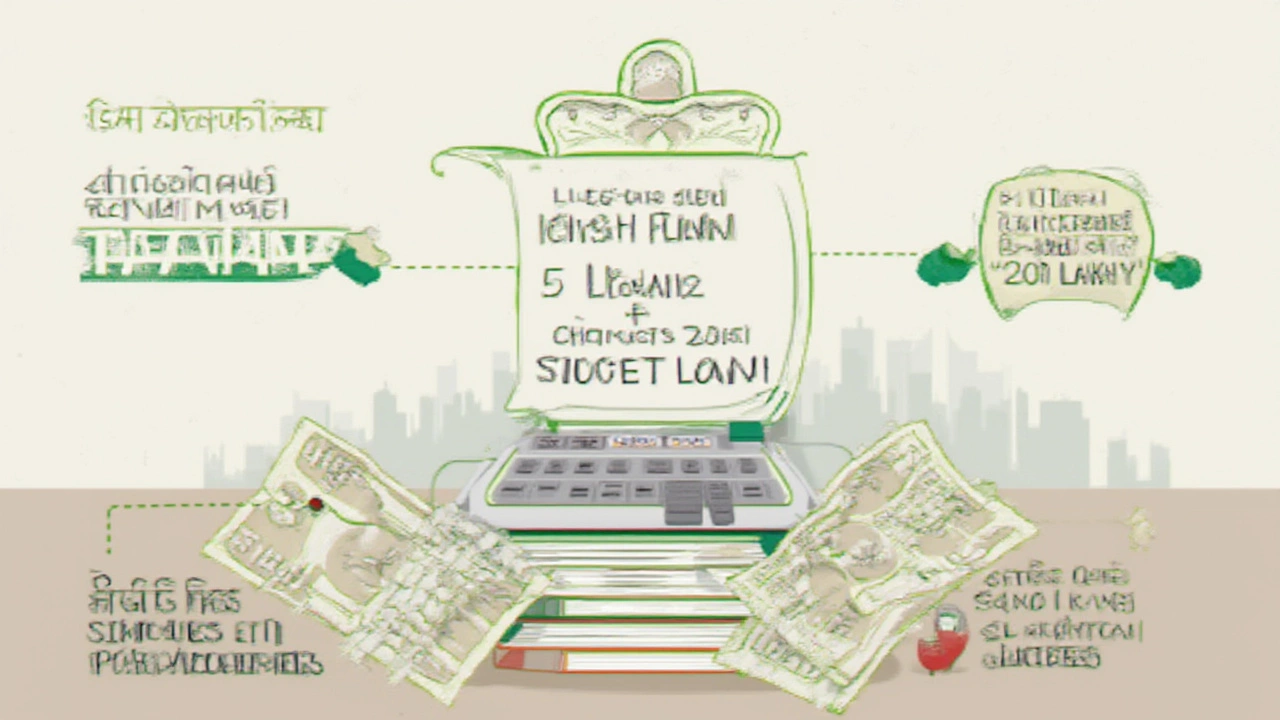
The monthly EMI for a big loan can feel like a nosy neighbor—always there whether you want it or not. Picture this: you finally decide to go for that 20 lakh loan. But the first thing running in your mind is, "How much do I have to shell out every month for 5 years?" I’ve been there myself, puzzling over numbers like decoding some secret message, while Kiwi, my parrot, squawks in the background and Keegan, my kid, asks if we’re rich yet. Let’s break it all down, so your next loan feels less like a maze and more like a well-marked trail.
Understanding EMI: What Are You Really Paying For?
EMI stands for Equated Monthly Installment. It’s basically a pre-set sum you pay every month to clear your loan within a chosen time. But it's not just the amount you borrowed. Each EMI has two pieces mixed in: a part that pays back the actual loan (called principal), and a part that goes toward the lender’s interest. With every payment you make, you owe a bit less, and gradually, the interest chunk shrinks while the principal part grows.
The EMI system is wildly popular for home loans, car loans, personal loans—you name it. What trips many people up isn’t the idea, but how those numbers actually play out over time. Lenders use a formula, but it’s not just about dividing the loan by the number of months. Interest throws a wrench into simple division. For a loan amount of 20 lakh (which is ₹2,000,000), the monthly EMI depends on how long you take to pay it off and the interest rate you lock in. Let’s pull back the curtain on what that really means.
Breaking Down the EMI Formula for a ₹20 Lakh, 5-Year Loan
Banks and lending apps everywhere use the same mathematical formula for calculating EMI. Here it is:
EMI = [P x R x (1+R)^N] / [(1+R)^N – 1]
Here’s what those letters mean:
- P = Principal loan amount (₹20 lakh or 2,000,000)
- R = Monthly interest rate (Annual Rate divided by 12 and then by 100)
- N = Number of monthly payments (loan tenure in months)
Let’s work through an example. Assume your lender offers an interest rate of 10% per year. That means:
- Yearly rate = 10%
- Monthly rate R = 10 / (12 x 100) = 0.008333
- Loan period N = 5 years = 60 months
Plug those numbers into the formula:
EMI = [2,000,000 x 0.008333 x (1+0.008333)^60] / [(1+0.008333)^60 – 1]
Crunch the numbers and you get an EMI of ₹42,494 (rounded to nearest whole rupee). So every month, for 60 months, you’ll be paying ₹42,494 straight from your bank account. To visualize, here’s how the math works for popular interest rates, for a 20 lakh loan across 5 years:
| Interest Rate (per annum) | Monthly EMI (₹) | Total Payable (₹) | Total Interest (₹) |
|---|---|---|---|
| 8% | 40,507 | 24,30,420 | 4,30,420 |
| 10% | 42,494 | 25,49,640 | 5,49,640 |
| 12% | 44,746 | 26,84,760 | 6,84,760 |
Notice how a small bump in the interest rate can mean lakhs more spent over the 5 years. If you’re someone like me who counts every extra rupee, you can see why picking the right deal matters.

How to Use EMI Calculators to Save Time and Avoid Mistakes
Don’t sweat if those numbers make your head spin. The easiest way to dodge manual math is with good EMI calculators. Tons of bank websites offer them for free. All you need to do is punch in your loan amount, the interest rate, and the tenure—out pops your monthly EMI, often instantly. I use one every time I compare loan options, and it takes the guesswork out of random deals lenders throw at you. Some calculators even break down your repayment schedule month-by-month, showing how the interest and principal shift as you go along.
Handy tip: Use EMI calculators to test “what if” scenarios. What if you increased your tenure to 6 years? Or found a lender at 9.5% interest instead of 10%? You’ll see right away how that affects your monthly outgo. For example, stretching your loan by an extra year drops your monthly EMI, but nudges your total interest higher. Shortening it does the reverse—EMIs get chunkier, but you clear the loan faster and cough up less to the bank. This trick has helped me sort out big decisions, especially when budget planning with Keegan’s school fees in mind.
Here’s a real-world scenario. Say you plan to prepay a lump sum in the middle of your loan—maybe you landed a bonus at work. Most calculators let you plug that in and show how much shorter your loan becomes, and how much you save on interest. Pretty slick, right?
Banks, Interest Rates, and Real-World EMI Hacks
So, which lender should you trust, and can you really negotiate that EMI down? Fact is, lenders are competitive, especially if you have a good repayment record or a steady job. Public-sector banks like SBI or PNB often offer slightly lower interest rates than private lenders, but private banks can woo you with faster processing or top-up deals. Don’t be shy to ask for better rates or waive-off fees—sometimes, it works. Last Diwali, I helped a friend save half a percent on his rate just by haggling a bit and showing offers from rival banks.
Another cool hack: If your credit score is above 750, you’re in a better position to nab lower interest. Working in a government job or a reputed company also bumps your odds. Also, double-check the fine print for hidden charges—processing fees, prepayment penalties, or insurance add-ons can quietly stack up. I once missed a clause that added a surprisingly hefty charge on foreclosure. Painful lesson learned.
Fixed versus floating rates is another key topic. Fixed rates give you a steady EMI, no surprises. Floating rates can move up or down with the market. Depending on how rates are moving—a bit of research on the current cycle helps here—you might end up paying less over time, or sometimes more. It’s a bit like betting on the weather, but a good bank manager should be able to explain the pros and cons for your needs.

Smart Habits for Managing Your 20 Lakh Loan
If you’re staring at a 5-year EMI journey, a few habits can make the ride much less bumpy:
- Set up automated payments from your main bank account to dodge late fees. Nothing sinks your credit score faster than missed payments.
- Every time you get an income spike—a bonus, work from a side gig, or your home garden project earning extra cash—consider making a partial prepayment. In the early years, this cuts interest sharply.
- Review your loan statement every few months. Glance for new charges or unexpected changes in dues.
- Some banks let you pay in advance for a few months. If extra funds are lying idle, this acts as a buffer during tight months.
- Revisit your insurance coverage too. Life insurance covering your loan amount saves family from repayment worries if something goes wrong.
Here’s something people often miss—loan refinancing. If you learn that the market rates have dropped a lot since you picked your loan, check if switching to a new bank (or even renegotiating with the same one) would be worth it. Just watch out for switching costs before you jump ship.
What worked for me was making a yearly goal to reduce my principal. Each time I paid even a little extra, I was surprised at how much interest it sliced off in the final tally. Kiwi the parrot might not get it, but my bank statement sure did!








Write a comment